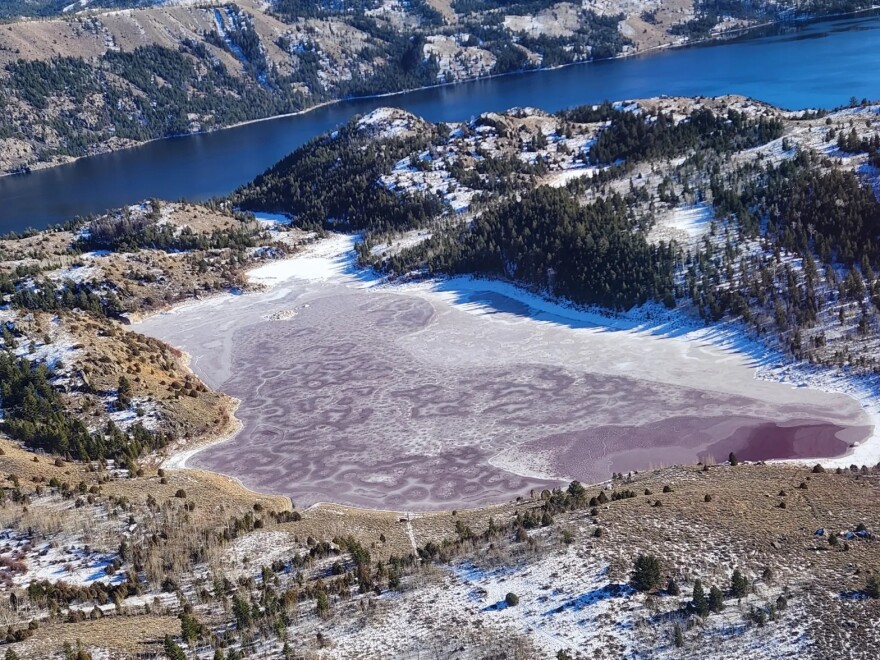A dark, murky brownish-red. That’s the color of Sublette County’s Little Soda Lake as of the last few weeks.
The small, alkaline lake sits about 10 miles northeast of Pinedale. It turned an even starker red last November, as first reported by WyoFile. At the time, authorities were shocked and didn’t know why the otherworldly hue was settling into a once beloved fishing lake.
There’s still a lot of questions. But a year of research led by the Wyoming Department of Environmental Quality (DEQ) and the Bridger-Teton National Forest has led to some answers.

The red color is likely coming from a native nontoxic algae, called cryptophyte.
“They typically occur [in] brackish type of waters, so waters with high salinity, high hardness,” said Eric Hargett, DEQ’s supervisor of Surface Water Quality Standards Program. “It usually has an affinity for cool water environments, so that may be why we may be seeing more of the red color as we go into the late summer and the early fall.”
Little Soda Lake wasn’t red over the summer. The color only started shifting in the last month or so, with the red hue only more noticeable in the last couple of weeks, which is similar to the timing last year.
“It seems to happen for a few weeks, maybe a month, and then it goes away,” Hargett said. “But that's all we know at this time.”
Hargett said they also don’t know why the lake only started turning red last year.
“But then again, we just actually started to monitor it just this year, and so it may have turned a red color in the past,” he said.
Hargett added they’ve detected the nontoxic algae in other similarly presenting, high-elevation lakes. He said a red hue has occasionally popped up in small bodies of water in the Red Desert and Albany County’s Hutton Lake.

As for Little Soda Lake, the color change brought a noticeable foul stench. The lake is tucked away in a landscape that looks like a bowl, surrounded by trees and sagebrush. As soon as one is in that bowl area and can see the water, the smell becomes overwhelming.
Hargett’s only explanation is that the lake is a closed basin system, meaning it has no outlet.
“When you get low water levels and perhaps some elevated sorts of temperatures, you can get some of that decomposition that occurs just naturally,” he said. “That may be one reason for the smell that you're detecting.”
While the cryptophytes are nontoxic, Little Soda Lake is also dealing with harmful cyanobacteria blooms (HCBs), which can be toxic. In fact, it was one of the first bodies of water on DEQ’s bloom advisory list this year. It’s remained on the list since May 12.
“It will most likely remain that way until we lift all advisories [on] December 31,” said Rachel Eyers, DEQ’s harmful cyanobacteria bloom (HCB) coordinator.
Little Soda Lake isn’t on the DEQ’s toxic HCB list, just a bloom advisory. But Eyers said HCBs can reach toxic thresholds “at any time.” Signage is posted around the lake to avoid contact for both humans and animals. However, wild ducks still seem to use the lake and cattle graze in the area during the summer.

“We've been in contact with that grazer. He's been letting us know if he sees potential blooms,” Eyers said. “Our guidance is to limit access to water when a bloom is present, and so that way they can make the informed decision that's best for them.”
The area around Little Soda Lake will close to human presence Dec. 1 until April 30 for wildlife winter protections. Researchers plan to continue studying the water next year to hopefully get more answers.








